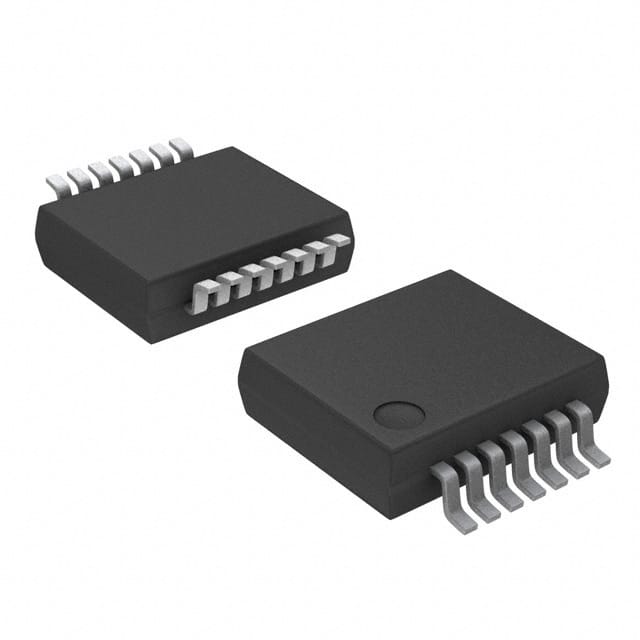74LV393DB,118
Product Overview
- Category: Integrated Circuit (IC)
- Use: Digital Logic
- Characteristics: Dual 4-bit binary ripple counter with individual clock inputs and asynchronous reset
- Package: SSOP (Shrink Small Outline Package)
- Essence: Counter IC for digital applications
- Packaging/Quantity: Tape and Reel, 2500 units per reel
Specifications
- Supply Voltage Range: 1.65V to 5.5V
- High-Level Input Voltage: 2V (minimum), VCC (maximum)
- Low-Level Input Voltage: GND (minimum), 0.8V (maximum)
- High-Level Output Voltage: VCC - 0.7V (minimum), VCC (maximum)
- Low-Level Output Voltage: GND (minimum), 0.1V (maximum)
- Maximum Operating Frequency: 125 MHz
- Operating Temperature Range: -40°C to +85°C
Detailed Pin Configuration
The 74LV393DB,118 IC has a total of 14 pins. The pin configuration is as follows:
- Clock B Input (CPB)
- Reset B Input (RSTB)
- Q3 Output (Q3)
- Q2 Output (Q2)
- Q1 Output (Q1)
- Q0 Output (Q0)
- Ground (GND)
- Clock A Input (CPA)
- Reset A Input (RSTA)
- Carry Output (CO)
- Q3 Output (Q3)
- Q2 Output (Q2)
- Q1 Output (Q1)
- VCC (Supply Voltage)
Functional Features
- Dual 4-bit binary ripple counter with independent clock inputs and asynchronous reset
- Can be used as a divide-by-n counter by connecting the appropriate outputs to the clock inputs
- Asynchronous reset allows immediate clearing of the counter to its initial state
- Outputs can be used as clock signals for other devices
Advantages and Disadvantages
Advantages: - Dual counter functionality saves board space and reduces component count - Wide supply voltage range allows compatibility with various systems - High operating frequency enables fast counting operations
Disadvantages: - Limited maximum operating frequency compared to some other counter ICs - SSOP package may require careful handling during assembly
Working Principles
The 74LV393DB,118 is a dual 4-bit binary ripple counter. It counts from 0 to 15 (in binary) based on the clock inputs (CPA and CPB). The counter advances on each rising edge of the clock input. The asynchronous reset inputs (RSTA and RSTB) allow the counter to be cleared to its initial state (0) at any time, regardless of the clock inputs.
Detailed Application Field Plans
The 74LV393DB,118 is commonly used in digital applications that require counting or dividing functions. Some potential application fields include:
- Frequency Division: The IC can be used to divide an input clock signal by a specific factor, generating lower-frequency clock signals.
- Event Counting: It can be utilized to count events or pulses in various systems, such as industrial automation, robotics, or electronic instrumentation.
- Time Delay Generation: By connecting the appropriate outputs to the clock inputs, the IC can generate precise time delays in circuits.
Detailed and Complete Alternative Models
Some alternative models that provide similar functionality to the 74LV393DB,118 are:
- CD4017: Decade Counter/Divider IC
- 74HC393: Dual 4-bit Binary Ripple Counter IC
- 74LS93: 4-bit Binary Ripple Counter IC
These alternative models can be considered based on specific requirements and compatibility with the system.
Word count: 511 words
Senaraikan 10 soalan dan jawapan biasa yang berkaitan dengan aplikasi 74LV393DB,118 dalam penyelesaian teknikal
Sure! Here are 10 common questions and answers related to the application of 74LV393DB,118 in technical solutions:
Q: What is the function of the 74LV393DB,118? A: The 74LV393DB,118 is a dual 4-bit binary ripple counter that can be used for various counting applications.
Q: What is the maximum operating frequency of the 74LV393DB,118? A: The maximum operating frequency of the 74LV393DB,118 is typically around 100 MHz.
Q: How many inputs does the 74LV393DB,118 have? A: The 74LV393DB,118 has two independent clock inputs (CP0 and CP1) and two asynchronous reset inputs (MR0 and MR1).
Q: Can I use the 74LV393DB,118 as a frequency divider? A: Yes, the 74LV393DB,118 can be used as a frequency divider by connecting the appropriate clock input and using the outputs accordingly.
Q: What is the power supply voltage range for the 74LV393DB,118? A: The power supply voltage range for the 74LV393DB,118 is typically between 2.0V and 5.5V.
Q: How many output pins does the 74LV393DB,118 have? A: The 74LV393DB,118 has four output pins (Q0, Q1, Q2, and Q3) which represent the binary count.
Q: Can I cascade multiple 74LV393DB,118 counters together? A: Yes, you can cascade multiple 74LV393DB,118 counters together to increase the number of bits in the counter.
Q: What is the maximum propagation delay of the 74LV393DB,118? A: The maximum propagation delay of the 74LV393DB,118 is typically around 10 ns.
Q: Can I use the 74LV393DB,118 in both synchronous and asynchronous counting modes? A: Yes, the 74LV393DB,118 can be used in both synchronous and asynchronous counting modes depending on the clock inputs used.
Q: Are there any specific precautions to consider when using the 74LV393DB,118? A: It is important to ensure proper power supply decoupling and avoid exceeding the maximum ratings specified in the datasheet to prevent damage to the device.
Please note that these answers are general and may vary depending on the specific application and requirements.


